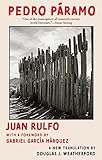
 We’re attempting to unravel the tangled web of literary influence by talking with the great writers of today about the writers of yesterday who inspired them. This month, Mexican writer Valeria Luiselli, author of such books as Lost Children Archive and The Story of My Teeth, explores the new translation of Juan Rulfo’s landmark text Pedro Páramo.
We’re attempting to unravel the tangled web of literary influence by talking with the great writers of today about the writers of yesterday who inspired them. This month, Mexican writer Valeria Luiselli, author of such books as Lost Children Archive and The Story of My Teeth, explores the new translation of Juan Rulfo’s landmark text Pedro Páramo.
What do you think of the new translation of Pedro Páramo?
 I have been forever frustrated with the existing translations because I think it’s the greatest novel ever written, and I knew very few people in the English-speaking world who had read it. There’s this kind of despective ignorance. It somehow never really made its way into the Anglophone imagination, and I think largely because the translations were so perfectable.
I have been forever frustrated with the existing translations because I think it’s the greatest novel ever written, and I knew very few people in the English-speaking world who had read it. There’s this kind of despective ignorance. It somehow never really made its way into the Anglophone imagination, and I think largely because the translations were so perfectable.
In the first translation there are entire lines and parts of the original missing. Reportedly the translator didn’t understand everything and when he didn’t he just kind of skipped over it. Then the second translation was the one that I read more times and even taught a few times when I started teaching, and it was always very frustrating because the language was so different from Rulfo’s. So much more florid. It really missed the very dry, sullen, somber tone.
And then this last translation, I think, is the best so far. I read somewhere years ago that translations of classics—be they ancient classics or modern classics—have to be redone at least every ten years to kind of renew the life of the book. I do think there are things that can be made better, but he got the most important thing in the book, which is rhythm. And rhythm is an offshoot of syntax, so that means he got the syntax well, so the translator obviously has an ear. I think my only hesitance with the translation is the lexicon. There are certain word choices that I found a little jarring. But it’s just lexicon, and that’s always perfectable. I think the undercurrent of the book, what carries the book—which is its rhythm—is very finely done.
I thought it brought out some stunning visual language that previous translations had lost.
There are some really beautiful lines. There’s a description of birds flying and turning blue, but what turns blue are the sounds of the birds. So there’s this very fine transition in the book from sonic experience to visual experience. It’s almost synesthetic. I don’t know if Rulfo had some degree of synesthesia or if it’s a crafted synesthesia. But those are well rendered in this new translation.
You called it the greatest novel ever. Why?
 I think he wrote it with the freedom of a first book that you never have again. It’s written with a freedom that teaches the reader that that freedom is possible in storytelling. It’s contagious in its freedom. It breaks time and space in a way that very few novels can while remaining comprehensible. It’s not Finnegan’s Wake. It remains comprehensible. It’s not easy, but it remains readable but also completely shatters time and space.
I think he wrote it with the freedom of a first book that you never have again. It’s written with a freedom that teaches the reader that that freedom is possible in storytelling. It’s contagious in its freedom. It breaks time and space in a way that very few novels can while remaining comprehensible. It’s not Finnegan’s Wake. It remains comprehensible. It’s not easy, but it remains readable but also completely shatters time and space.
And that’s the biggest constraint a novelist has—how the hell do you make time in a novel in a way that it feels real? That the reader is traveling with you in time? And usually the solution to that very difficult question of how do I make time, how do I embroider it, is to keep to time as much as possible, right? Even if you’re working in a fragmented sense of time, each individual section or fragment keeps to its time. But Rulfo really does away with it. He travels in time and space with an absolute freedom without us getting lost. If we’re paying enough attention we don’t get lost. So that’s one of the qualities that I think make it one of my favorite novels of all time. I think the other things have to do with his ear for the vernacular. The way he reproduces voice. You can almost hear the ghosts.

